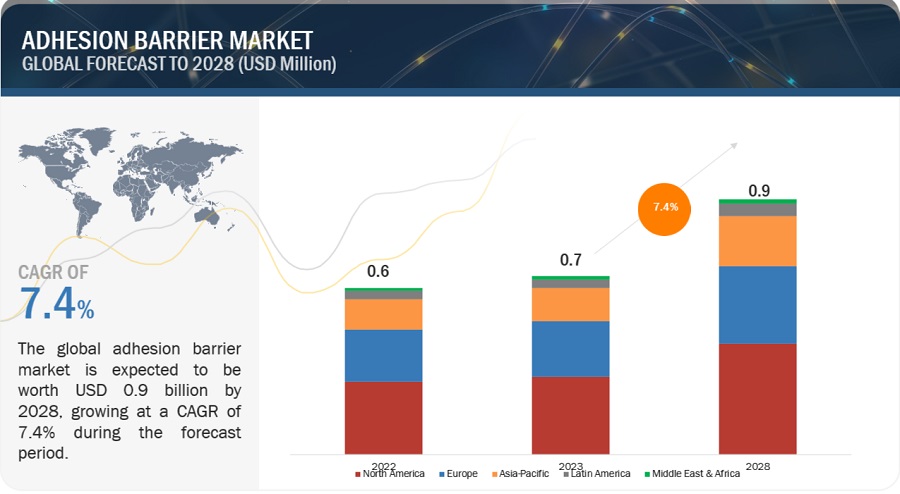The global adhesion barrier market was valued at $0.7 billion in 2023 and is projected to reach $0.9 billion by 2028, growing at a compound annual growth rate (CAGR) of 7.4% during this period. The latest research provides an in-depth analysis of market trends, pricing, patents, conference materials, key stakeholders, and buying behaviors.

Adhesion Barrier Market Drivers
- Aging Population: The rise in the elderly population is a significant driver, as older individuals often require more surgeries.
- Increased Surgeries and Sports Injuries: A higher number of surgeries and sports-related injuries necessitates the use of adhesion barriers to prevent complications.
- Awareness: Growing awareness about adhesions and their associated complications is boosting market growth.
Adhesion Barrier Market Restraints
- Surgeons’ Reluctance: Despite the known benefits, many surgeons hesitate to use adhesion barriers due to a lack of robust clinical evidence supporting their safety and efficacy. This skepticism hinders market growth.
Adhesion Barrier Market Dynamics
Key Trends
- Surgery Volume and Complications: Adhesion barriers are crucial in preventing post-surgical complications, such as severe abdominal pain, infertility, and physical impairments.
- Synthetic Adhesion Barriers: These products are gaining popularity due to their resorbable nature, eliminating the need for a second surgery.
Opportunities
- Emerging Markets: Low penetration in regions like Asia Pacific, Latin America, and the Middle East presents significant growth opportunities. Countries such as South Korea, China, India, Mexico, and Brazil are experiencing an increase in surgical procedures and medical tourism, creating a demand for adhesion barriers.
Challenges
- Regulatory Hurdles: Strict regulations and the high cost and time associated with developing new products limit technological innovation in the market.
Adhesion Barrier Market Segmentation
By Product
- Synthetic Products: Include hyaluronic acid, regenerated cellulose, polyethylene glycol, and others.
- Natural Products
By Formulation
- Film Formulations: Dominated the market in 2022 due to a wide range of products and strong clinical evidence supporting their efficacy.
- Gel and Liquid Formulations
By Application
- Surgical Procedures: Gynecological, general/abdominal, orthopedic, cardiovascular, neurological, urological, reconstructive surgeries, and others.
By End User
- Hospitals and Clinics: Accounted for the largest market share in 2022 due to the high volume of surgical procedures performed.
- Ambulatory Surgical Centers
Adhesion Barrier Market Regional Insights
Asia Pacific
- Fastest Growing Market: Due to a large population, economic growth, and increasing healthcare investments. Government initiatives and rising surgical procedures drive the demand for advanced healthcare facilities and adhesion barriers.
Adhesion Barrier Market Ecosystem
Key Players
- Prominent Companies: Baxter International, Johnson & Johnson, Becton, Dickinson and Company, Integra LifeSciences, Anika Therapeutics, Atrium Medical Corporation, FzioMed, MAST Biosurgery, Innocoll, Betatech Medical, CorMatrix Cardiovascular, Terumo Corporation, BiosCompass, W.L.Gore & Associates, GUNZE Limited, Leader Biomedical, Xlynk Surgical, Luna Solutions, PlantTec Medical GmbH, Actamax Surgical Materials, Arc Medical Devices, CG Bio, Seikagaku Corporation, Hangzhou Singclean Medical Products, and Allosource.
Adhesion Barrier Industry Recent Developments:
- Baxter: Acquired Seprafilm Adhesion Barrier and related assets from Sanofi in February 2020 to enhance its hemostatic and sealant portfolio.
- Integra LifeSciences: Acquired Acell Inc. in January 2021 to expand its complex wound management solutions.
Conclusion
The global adhesion barrier market is on a growth trajectory, driven by an increasing number of surgeries and rising awareness of post-surgical complications. However, the reluctance of surgeons and stringent regulations pose challenges. The Asia Pacific region offers significant growth opportunities due to its burgeoning healthcare sector.
